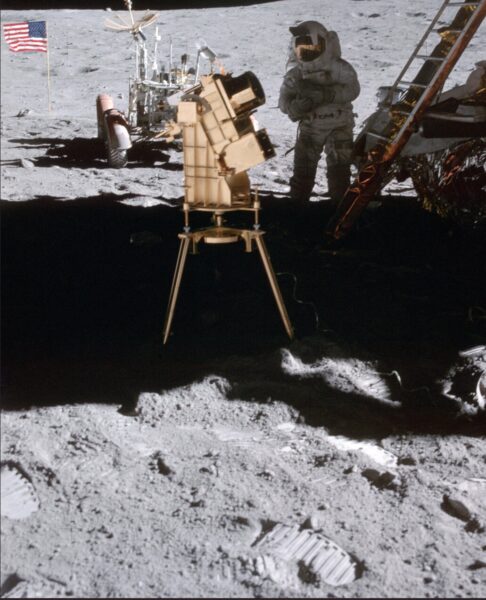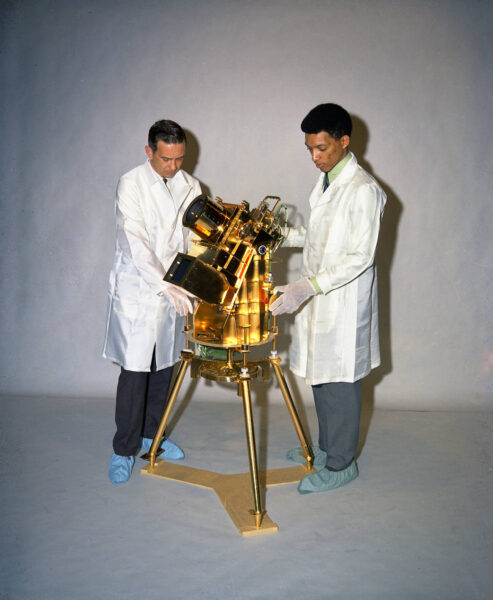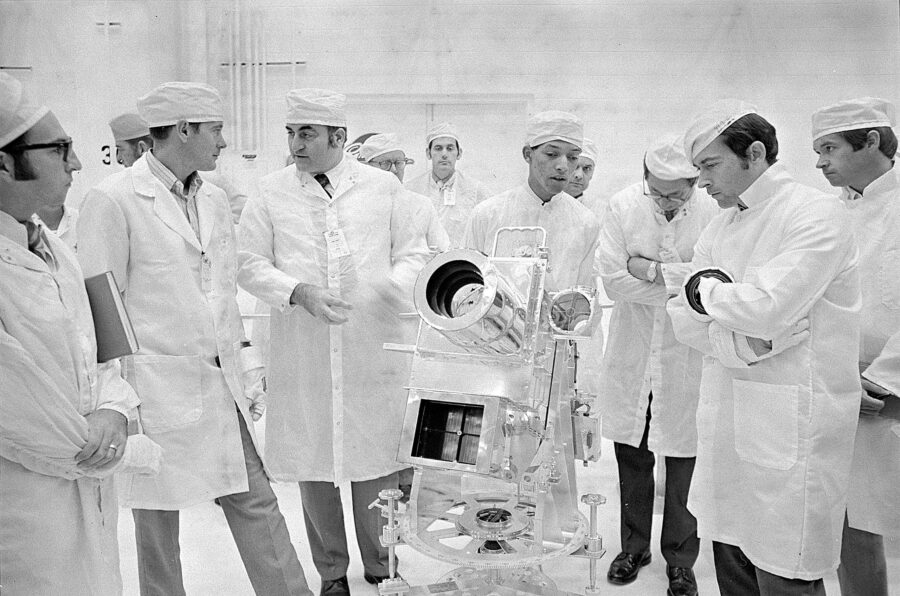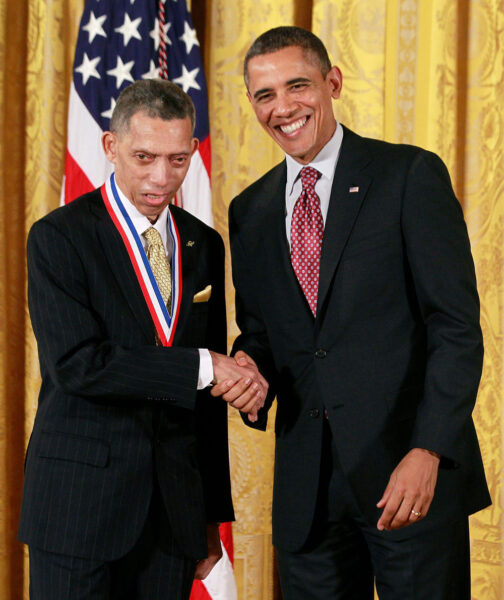Astronomer and engineer George Carruthers (1939–2020) designed and built the first observatory on another world.
Humanity’s greatest monuments — from the Great Pyramid of Giza to the Washington Monument — will all likely be long gone by the time the memorial to Dr George Carruthers fades from existence. This is because Carruthers, who passed away at the age of 81 on December 26, 2020, is immortalized on the Moon. There, in the shadow of the abandoned Orion lunar module, sits a 2-foot, 7-inch gold-plated camera that Carruthers designed and built: the first astronomical telescope to observe the heavens from another celestial body.

NASA
A New Way of Seeing
The Far Ultraviolet Camera/Spectrograph, as it is known, is a world away from Carruthers’ earliest attempt at building a telescope. At the age of 10, he constructed a simple refractor from some cardboard tubing and a lens kit from a magazine. His second attempt, after his family moved from rural Ohio to Chicago following his father’s death, showed more promise.
As part of a high school science fair project, Carruthers ground and polished his own mirrors at the Adler Planetarium. Then, taking inspiration from “pictures in Sky and Telescope magazine,” as he recalled in a 1992 American Institute of Physics interview, he constructed a wooden tube and mounting. He used his telescope “to show the kids in the neighborhood what Jupiter looked like and Saturn and things like that.” Even in these early years, though, Carruthers was yearning to build something better.
To do so, he needed to put in the hard yards. In 1957 — the year Sputnik 1 launched — Carruthers entered the University of Illinois. There, he soaked up valuable knowledge through his undergraduate and graduate studies, which culminated in a PhD in aeronautical and astronautical engineering in 1964. He immediately joined the Naval Research Laboratory (NRL) in Washington, DC, as a research physicist. From there, his telescope-making career took off.
Carruthers’ work at NRL focused on astronomy in the far-ultraviolet (FUV), an area of the electromagnetic spectrum that contains important astrophysical information about stars, gas, and dust. Given that the Earth’s atmosphere acts like a shroud to ultraviolet light, ground-based observatories were and are blind to FUV. To get around this, engineers started outfitting sub-orbital sounding rockets with detectors. However, when Carruthers joined the fray, existing technology was bulky, fragile, and ill-suited to high-precision FUV astronomy.
By the late 1960s, Carruthers had solved the problem, inventing an FUV telescope that would go on to define the rest of his professional life. More sensitive and quantitative than analog imaging, the telescope captured FUV spectra by converting photons into energetic electrons. These were then amplified and recorded by electron-sensitive film. Carruthers described his “electrographic” telescope as a camera that “uses film but is also an electronic imaging device.”

U.S. Naval Research Laboratory
Patented as an “image converter for detecting electromagnetic radiation especially in short wave lengths,” his compact telescope flew aboard a sounding rocket in 1970 and captured irrefutable evidence of molecular hydrogen in interstellar space. This discovery led to a deeper understanding of cosmic hydrogen’s key role in assembling structure in the early universe and its continued influence on star formation.
Meanwhile, Carruthers had already started work on a far more ambitious application for his telescope design: as the first Moon-based observatory. Leading a large group of scientists, engineers, and contractors under NASA’s auspices, Carruthers developed, built, and trained astronauts to use the Far-Ultraviolet Camera/Spectrograph in time for Apollo 16’s launch on April 16, 1972.
During the 48 hours in which Carruthers’ telescope was in use on the Moon, Commander John Young shot 185 exposures, training the device on 10 specific targets of interest covering 8% of the sky. At the end of the mission, the astronauts removed the film from the device and returned it to Earth. Though a success in terms of operation, no one knew if the instrument had captured useful data. It would take an anxious two-week wait after the astronauts had splashed back down on Earth before Carruthers and his team could see the processed images for themselves.
They would not be disappointed. The camera had captured Earth in FUV light for the very first time, revealing the full extent of our atmosphere, the polar auroral zones, and the tropical airglow belt. And it had provided a survey of more than 550 stars, nebulae, and galaxies that would have been impossible to see from the ground.

NASA
The following year saw a stripped-down, spare version of Carruthers’ Far-Ultraviolet Camera/Spectrograph sent to the first U.S. space station, Skylab. The Skylab 4 crew wielded it to observe stars and interstellar clouds as well as its primary target: Comet Kohoutek (C/1973 E1). Although the press later dubbed Kohoutek “the flop of the century,” due to its disappointing brightness as seen from Earth with the naked eye, for scientists the comet was a boon — the first one that astronomers could study in depth.
For their part, Skylab astronauts managed to capture the hydrogen corona surrounding the comet, though Carruthers collected better data from a group of similar UV cameras flown aboard a sounding rocket over New Mexico around the same time. The observations contributed to astronomers’ understanding of comets’ structure and origins.
Using the same electrographic imaging technique flown on Apollo 16, Skylab, and many sounding rocket flights, Carruthers went on to collect FUV images of Halley’s Comet in 1986, and in 1991 and 1995 his devices were launched with space shuttle missions to snap images of interstellar gas and dust.
By the mid-1990s, the development of highly effective CCD imagers that could capture and beam data back to Earth obviated the need to return film from space. Carruthers in turn fully embraced electronic imaging. With his team at NRL, Carruthers’ last major personal scientific achievement was to work on the design of the Global Imaging Monitor of the Ionosphere, an electron bombardment CCD device, which flew aboard the Advanced Research and Global Observation Satellite, launched in 1999.
Thinking of the Future
As one of the country’s leading African American astrophysicists, Carruthers’ love for science was matched only by his passion for involving African American and other underrepresented groups in science and technology careers. He was Vice-President of Project SMART (Science, Mathematics, Aerospace, Research, and Technology), a program to prepare young people for future careers in science and technology. And he helped launch the Science and Engineering Apprenticeship Program (SEAP), which provides high school students the opportunity to do research at NRL and other labs in the Department of Navy to this day.

Reuters / John Reed
After his retirement from NRL in 2002, Carruthers took a position at the historically black Howard University in Washington, DC where he continued to devote much of his time to mentoring young students and conducting outreach activities. He organized summer workshops and regular family nights at the university’s observatory. And he taught Earth and space science to undergraduates and DC public school teachers for a decade, until — at the age of 73 — his health started to deteriorate.
“I have fond memories of George bringing his bike inside the research building . . . and chatting with students animatedly in the hallway — for an inordinate amount of time —with his helmet still on his head, while I was waiting for him to show up in my office,” recalls former colleague Prabhakar Misra. “George was a very shy person, but when he was in front of his peers or when he lectured students, he could leave you spellbound with the depth of knowledge he possessed.”
 0
0








Comments
You must be logged in to post a comment.